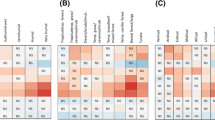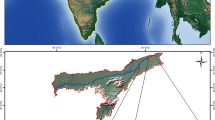Abstract
Different hypotheses about the genesis of gilgai microtopography and corresponding soil complexes with clayey swelling soils are considered in this review. Their diversity is stipulated by specificities of the objects themselves and by the history of studies of the composition, properties, regimes, and landscape conditions of the areas with Vertisols in different countries. Most of the hypotheses about the genesis of Vertisols with the gilgai microtopography suggest that strong swelling–shrinking processes take place in these soils in the course of moistening–drying cycles; the origin of shear stress in the soils, its spatial patterns, and the particular ways of translocation of the soil material are discussed. At the early stage of Vertisol studies, a hypothesis about the leading role of the process of “self-swallowing” of the soils as a result of filling of open cracks with the material from the upper soil horizons was popular. However, numerous facts suggest that the intensity of this process is relatively low, so that it cannot play the major role in the gilgai formation and cyclic changes in the thickness and properties of the soil horizons in Vertisols. Another important mechanism is the uneven moistening and drying of the whole soil volume resulting in the irregular distribution of inner tensions in the soil with the development of shear stress and plastic deformation of the soil mass. The hypotheses suggested in the recent decades are based on the models of soil mechanics. A number of hypotheses consider possible alternation and duration of evolutionary stages of the development of Vertisols with the gilgai microtopography.
Similar content being viewed by others
References
P. N. Berezin, A. D. Voronin, and E. V. Shein, “Physical principles and criteria of vertigenesis,” Vestn. Mos. Univ., Ser. 17: Pochvoved., No. 1, 31–38 (1989).
T. L. Bystritskaya and A. N. Tyuryukanov, Black Vertisols of Eurasia (Nauka, Moscow, 1971) [in Russian].
I. V. Kovda, E. G. Morgun, and Ya. G. Ryskov, “Structural and functional analysis of microcomplexes of gilgai soils: morphological features and humidity dynamics,” Pochvovedenie, No. 11, 1326–1339 (1995).
F. I. Kozlovskii and E. A. Kornblyum, Meliorative Problems of the Development of Steppe Floodplains (Nauka, Moscow, 1972) [in Russian].
I. A. Krupenikov, B. P. Podymov, E. E. Skryabina, V. E. Alekseev, and M. I. Smirnov, Vertisols of Moldavia: Genesis, Properties, Evolution, and Use (Shtiintsa, Chisinau, 1990) [in Russian].
Vertisols and Vertic Soils, Ed. by E. M. Samoilova (Moscow State University, Moscow, 1990) [in Russian].
N. B. Khitrov, “Vertisols with gilgai microtopography: classification and parameters of microtopography and morphological types of soils (a review),” Eurasian Soil Sci. 49 (2), 2016 (in press).
N. B. Khitrov, Genesis, Diagnostics, Properties, and Functioning of Clayey Swelling Soils of the Central Cis-Caucasus (Dokuchaev Soil Science Institute, Moscow, 2003) [in Russian].
N. B. Khitrov, “Properties and regimes of Vertisols with gilgai microtopography (a review),” Eurasian Soil Sci. 49 (3), 2016 (in press).
N. B. Khitrov, “Vertigenesis in soils of the Central chernozemic region of Russia,” Eurasian Soil Sci. 45 9, 834–842 (2012).
N. B. Khitrov, V. P. Vlasenko, and L. V. Rogovneva, “Statistical parameters of bowl-shaped and diapiric morphological structures in Vertisols of the Vorontsovskaya Depression,” Byull. Pochv. Inst. im. V.V. Dokuchaeva, No. 77, 3–28 (2015).
N. B. Khitrov, T. V. Korolyuk, T. V. Tursina, N. P. Chizhikova, G. A. Shershukova, I. A. Beleneva, and D. R. Morozov, “Gilgai Vertisols,” Pochvovedenie, No. 7, 33–44 (1994).
G. D. Aitchinson, “The mechanics of gilgai formation,” in Proceedings of the 1st Australian Conference on Soil Science (Adelaide, South Australia 1953), pp. 1–3.
“Vertisols and technologies for their management,” in Developments in Soil Science, Ed. by N. Ahmad and A. Mermut (Elsevier, Amsterdam, 1996), Vol. 24.
W. A. Blokhuis, “Morphology and genesis of Vertisols,” in 12th International Congress of Soil Science “Vertisols and Rice Soils of the Tropics” (New Delhi, India, 1982), pp. 23–47.
W. A. Blokhuis, “Vertisols,” in Encyclopedia of Soil Science (CRC Press, Boca Raton, FL, 2006). doi: doi 10.1081/E-ESS-12004277810.1081/E-ESS-120042778
J. Bouma and J. Loveday, “Characterizing soil water regimes in swelling clay soils,” in Vertisols: Their Distribution, Properties, Classification, and Management, Ed. by L. P. Wilding and R. Puentes (Texas A&M University Printing Center, College Station, TX, 1988), pp. 83–96.
C. E. Coulombe, L. P. Wilding, and J. B. Dixon, “Overview of Vertisols: characteristics and impacts on society,” Adv. Agron. 57, 289–375 (1996).
R. Dudal, “Dark clay soils of tropical and subtropical regions,” Soil Sci. 95 4, 264–270 (1963).
R. Dudal, Dark Clay Soils of Tropical and Subtropical Regions (Food and Agriculture Organization, Rome, 1965).
C. H. Edelman and R. Brinkman, “Physiography of gilgai soils,” Soil Sci. 94 6, 366–370 (1962).
Z. El Abedine, G. H. Robinson, and A. Commisaris, “Approximate age of the Vertisols of Gezira, Central Clay Plain, Sudan,” Soil Sci. 11 3, 200–207 (1971).
H. Eswaran, F. H. Beinroth, P. F. Reich, and L. A. Quandt, “Vertisols: their properties, classification, distribution and management,” in The Guy D. Smith Memorial Slide Collection (US Department of Agriculture, Washington, DC, 1999).
T. C. Gustavson, “Microrelief (gilgai) structures on expansive clays in the Texas coastal plain - their recognition and significance in engineering construction,” in Geological Circular 75-7 (University of Texas at Austin, Bureau of Economic Geology, Austin, 1975).
E. G. Hallsworth, G. K. Robertson, and F. R. Gibbons, “Studies in pedogenesis in New South Wales. VII. The “gilgai” soils,” J. Soil Sci. 6 1, 1–31 (1955).
E. G. Hallsworth and G. G. Beckmann, “Gilgai in the Quaternary,” Soil Sci. 107 6, 409–420 (1969).
E. W. Hilgard, Soils (Macmillan, New York, 1906).
A. Howard, “Crab-hole gilgai and self-mulching soils of the Murrumbidgee irrigation area,” Pedology 8, 14–18 (1939).
IUSS Working Group WRB, World Reference Base for Soil Resources International Soil Classification System for Naming Soils and Creating Legends for Soil Maps. World Soil Resources Reports No. 106 (Food and Agriculture Organization, Rome, 2014).
“Management of Vertisols in sub-Saharan Africa,” in Proceedings of a Conference of International Livestock Centre for Africa, Addis Ababa, Ethiopia, August 31–September 4, 1987, Ed. by S. C. Jutzi, I. Haque, J. McIntire, and J. E. S. Stares (International Livestock Centre for Africa, Addis Ababa, 1987).
R. K. Katti, R. K. Lal, S. K. Fotedar, and S. K. Kulkarni, “Depth effect in expansive clays,” in Proceedings of the Second International Research and Engineering Conference “Expansive Clay Soils” (Texas A&M University Printing Center, College Station, TX, 1969), pp. 362–373.
A. S. Kishné, C. L. S. Morgan, and W. L. Miller, “Vertisol crack extent associated with gilgai and soil moisture in the Texas Gulf coast prairie,” Soil Sci. Soc. Am. J. 73, 1221–1230 (2009).
M. J. Knight, “Structural analyses and mechanical origins of gilgai at Boorook, Victoria, Australia,” Geoderma 23, 245–283 (1980).
A. Komornik and J. G. Zeitlin, “Laboratory determination of lateral and vertical stresses in compacted swelling clay,” J. Mater. 5, 108–128 (1970).
G. W. Leeper, A. Nicholls, and S. M. Walton, “Soil and pasture studies in the Mount Gellibrand area, Western district of Victoria.” Proc. R. Soc. Vic. 49 1, 77–138 (1936).
B. Maxwell, “Influence of horizontal stresses on gilgai landforms,” J. Geotech. Eng. 120, 1437–1444 (1994).
B. Maxwell, The origin of hog-wallows and gilgai landforms— Part 1, 2013. http://thecosmiccornerblogspotru/ 2013/10/the-origin-of-hogwalllows-and-gilgaihtml
J. W. McGarity, “Melon-hole formation in the Richmond River district of N.S.W.,” in Proceedings of the 1st Australian Conference on Soil Science (Adelaide, South Australia 1953), pp. 1–7.
W. L. Miller, A. S. Kishné, and C. L. S. Morgan, “Vertisol morphology, classification, and seasonal cracking patterns in the Texas Gulf coast prairie,” Soil Surv. Horiz. 51, 10–16 (2010).
J. Moeyersons, J. Nyssen, J. Poesen, J. Deckers, and M. Haile, “On the origin of rock fragment mulches on Vertisols: a case study from the Ethiopian highlands,” Geomorphology 76, 411–429 (2006).
R. S. Murthy, J. C. Bhattacharjee, R. J. Landey, and R. M. Pofali, “Distribution, characteristics and classification of Vertisols,” in 12th International Congress of Soil Science “Vertisols and Rice Soils of the Tropics” (New Delhi, India, 1982), pp. 3–22.
L. C. Nordt, L. P. Wilding, W. C. Lynn, and C. C. Crawford, “Vertisol genesis in a humid climate of the coastal plain of Texas, U.S.A.,” Geoderma 122, 83–102 (2004).
C. D. Ollier, “Desert gilgai,” Nature 212 5062, 581–583 (1966).
I. R. Paton, “Origin and terminology for gilgai in Australia,” Geoderma 11, 221–242 (1974).
K. van der Meer, “Gilgai morphology of the Lufira Plain,” in Transactions of the 8th International Congress of Soil Science (Bucharest, Romania, 1964), pp. 697–701.
F. Verger, “Mottureaux et gilgais,” Ann. Géogr. 73 398, 413–430 (1964).
E. M. White and R. G. Bonestell, “Some gilgaied soils in South Dakota,” Soil Sci. Soc. Am. Proc. 24 4, 305–309 (1960).
L. P. Wilding, “Genesis of Vertisols,” in Proceedings of Fifth International Soil Classification Workshop, Sudan, 1982 (Soil Survey Administration, Khartoum, Sudan, 1985). P. 47-62.
Vertisols: Their Distribution, Properties, Classification, and Management, Ed. by L. P. Wilding and R. Puentes (Texas A&M University Printing Center, College Station, TX, 1988).
L. P. Wilding and D. Tessier, “Genesis of Vertisols: shrink-swell phenomena,” in Vertisols: Their Distribution, Properties, Classification, and Management, Ed. by L. P. Wilding and R. Puentes (Texas A&M University Printing Center, College Station, TX, 1988), pp. 55–81.
L. P. Wilding, D. Williams, W. Miller, T. Cook, and H. Eswaran, “Close interval spatial variability of Vertisols: a case study in Texas,” in Proceedings of the Sixth Soil Correlation Meeting (ISCOM) “Characterization, Classification, and Utilization of Cold Aridisols and Vertisols, Ed. by J. M. Kimble (National Soil Survey Center, Lincoln, NE, 1990), pp. 232–247.
D. H. Yaalon and D. Kalmar, “Dynamics of cracking and swelling clay soils: displacement of skeletal grains, optimum depth of slicken sides, and rate of intrapedonic turbation,” Earth Surf. Process. 3, 31–42 (1978).
Author information
Authors and Affiliations
Corresponding author
Additional information
Original Russian Text © N.B. Khitrov, 2016, published in Pochvovedenie, 2016, No. 5, pp. 531–541.
Rights and permissions
About this article
Cite this article
Khitrov, N.B. The genesis of vertisols with gilgai microtopography: A review. Eurasian Soil Sc. 49, 489–497 (2016). https://doi.org/10.1134/S1064229316050070
Received:
Published:
Issue Date:
DOI: https://doi.org/10.1134/S1064229316050070




